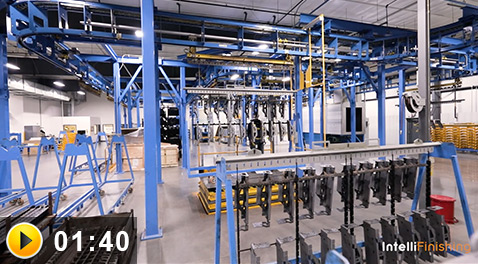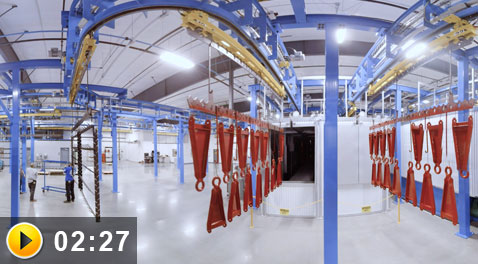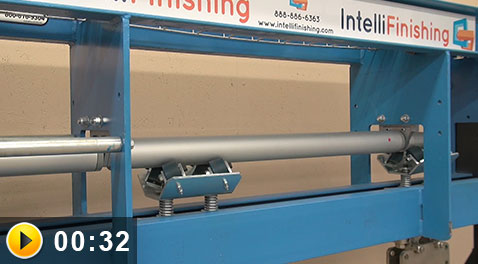Complete Powder Coating System Installed for Custom Fabricator
JR Custom Metal Products, Inc. produces many different parts and assemblies, made from different metal substrates for a variety of manufacturers. In 2017, IntelliFinishing installed a complete powder coating system in a 24,000 sq. ft. facility. IntelliFinishing systems provide the flexibility for the unknown, including future parts and processes, unlike powder coating systems that use overhead monorail conveyors. Powder coating systems that use overhead monorail conveyors are best suited for one size of part with no variations in processes. Since JR Custom Metal Products produces a variety of parts, they determined other solutions that used chain conveyors would not be a good fit, even though they were less costly.

or call 785-309-0356
Conveyor Path Spurs to Shot Blast
After parts are loaded, the recipe is selected for the group of parts on the loadbar. The recipe is tied to the carrier and its loadbar as it moves through the processes. If the group of parts require blasting, then the powder coating system offers an optional spur to the automated in-line shot blast equipment that is located in a separate room. Shot blast is a mechanical means of pretreatment and is considered one of the best methods to prepare metal parts for coating.
Process Washer with Rinse Options
Carriers loaded with parts proceed directly to the process washer after being loaded or blasted. The 4-stage process washer provides enhanced corrosion resistance plus offers two RO halo options with flash rust protection. After being washed, excess water is blown off of the parts by an operator after the carrier stops. The operator may choose to release the carrier early from an HMI terminal or wait until the automated movement occurs.
Carriers then proceed through the dry-off oven. Both the dry-off and cure ovens are equipped with automated doors at the entrance and exit to save energy. The split-top ovens allow the conveyor and carriers to remain out of the oven, reducing contamination.
Clean Room for Powder Coating
From the dry-off oven,the carrier of parts move to the clean room where the carrier stops if the recipe indicates masking is required for the group of parts. An operator may choose to release the carrier early or wait until the allotted time. After the masking station, the carrier proceeds to a powder coating booth where the carrier stops for the manual coating process.The painters may hold the part for more time or choose to release the part early if they are done before the allotted time. The rest of the processes are not affected if an operator chooses to hold a carrier for longer than the designated takt time.
The clean room is a separate environmental enclosure where temperature and humidity are adjusted to create optimal conditions for powder performance. The clean room was designed with room for the addition of an automatic spray booth with overspray reclaim.
Dual Lane Split-Top Cure Oven
Upon exiting the clean room, the carrier of parts enter the cure oven. This dual lane oven has a fast lane for quicker curing parts and a slow lane for parts requiring more time. The ovens have 6-inch, insulated walls to eliminate unnecessary heat loss, in addition to automatic doors.
The internal temperature of the cure oven is set to 400° while the insulated walls keep the external surface of the oven safe to the touch, registering approx. 98°.
The structure of the conveyor and mechanical components are suspended above the oven, while the loadbar and parts proceed through the split-top oven. Air knives in the split-top oven decrease the amount of heat that is transferred to the environment. This is demonstrated in this installation when the temperature of the carrier components suspended above the oven register 104°.
After exiting the cure oven, the carrier of parts move through cool down. They will then be unloaded and packaged for shipping.
Automation, Controls and Conveyor
Employees can easily manage the conveyor, equipment, processes and recipes from three centrally located HMI terminals. The complete system may be reviewed at any of the HMI terminals and employees can easily see where carriers are in the process.
The unique conveyor design allows carriers to move at different speeds, including faster through non-value added areas.







